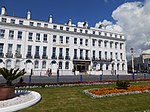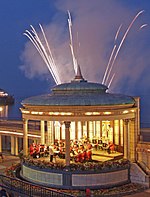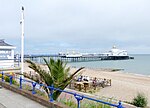Central Methodist Church, Eastbourne

The former Central Methodist Church was until 2018 the main Methodist place of worship in Eastbourne, a town and borough in the English county of East Sussex. The large town-centre building, with attached schoolrooms and ancillary buildings, was the successor to earlier Methodist places of worship in the area. Soldiers brought the denomination to the area in 1803, when an isolated collection of clifftop villages stood where the 19th-century resort town of Eastbourne developed. A society they formed in that year to encourage Methodism's growth and outreach survives. Local Methodist worshipper and historian Carlos Crisford designed the lavish church in 1907, and it has been used for worship ever since—even as several other Methodist churches in the town and surrounding villages have declined and closed. For several years until 2013, it also housed a Baptist congregation displaced from their own church building. Central Methodist Church is a Grade II listed building. A reorganisation of Methodist worship in the Eastbourne area and closer links with the United Reformed Church led to the formation of a Local ecumenical partnership in early 2018 between Central Methodist Church, Greenfield Methodist Church and two United Reformed congregations, which all came together under the name Emmanuel Church. Worship was consolidated at one of the buildings pending a rebuilding project to provide a new church and community building, and the other premises—including Central Methodist Church—were vacated. The church was then occupied by a Pentecostal group, which has renamed the premises Deliverance Centre Eastbourne and which continues to use the church as its main place of worship.
Excerpt from the Wikipedia article Central Methodist Church, Eastbourne (License: CC BY-SA 3.0, Authors, Images).Central Methodist Church, Eastbourne
Susan's Road,
Geographical coordinates (GPS) Address External links Nearby Places Show on map
Geographical coordinates (GPS)
| Latitude | Longitude |
|---|---|
| N 50.7689 ° | E 0.2888 ° |
Address
Central Methodist Church
Susan's Road
BN21 3TJ , Roselands
England, United Kingdom
Open on Google Maps








